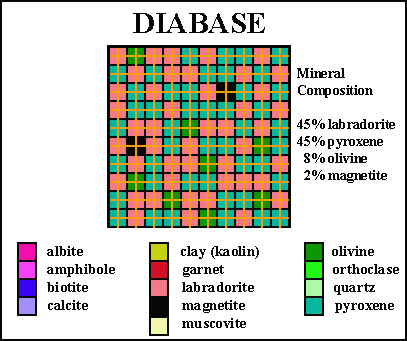|
INTRODUCTION:The goal of this exercise is to determine the percentages of the different minerals in the geologic materials underlying the New York City area. To make the exercise simpler, the materials are represented diagrammatically rather than by microscope drawings. In these diagrams, all the mineral grains are shown as squares of equal size. Moreover, to simplify the calculation of percentages, the number of squares and grid intersections is set at one hundred.
Follow the steps listed in the example:
EXAMPLE:
- Click on the blue button and print a copy of the Mineral Composition Tabulation Sheet (printout # Q-1).

- Examine the diagram that represents the rock diabase. The mineral grains are shown as squares of equal size. They are overlain by a grid (shown in orange) whose intersections over lie the centers of the squares. The colors in the legend indicate diabase is composed of pyroxene, labradorite, magnetite and olivine. Count the number of intersections that overlie each of these minerals. Because there are 100 intersections, those numbers will be equal to the percentages of those minerals in the rock. Diabase is composed of 45% pyroxene, 45% labradorite, 2% magnetite, and 8% olivine.
- Enter the mineral percentages in the appropriate rows in the diabase column in the Mineral Composition Tabulation Sheet (printout # Q-1).
|
 |
